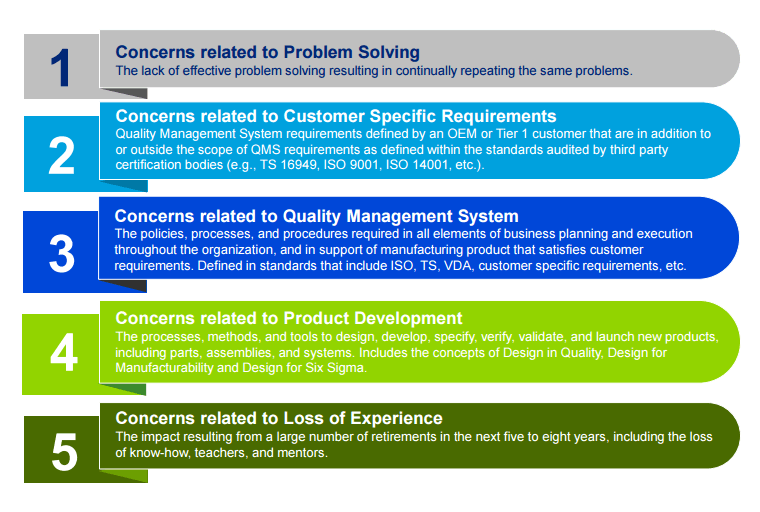Problem Solving is an Essential Skill
The importance of ‘Problem Solving’ and the ‘Continuous Improvement Process’ has been recognized by quality improvement experts, and management gurus for many years – including Phil Crosby and William Edwards Deming. But in the real world of industrial production and management, effective problem solving remains the exception rather than the rule, as managers and political leaders tolerate, or encourage, ‘short-term fixes’ rather than grappling with the underlying causes of our current difficulties.
Phil Crosby set out some basic principles for a problem solving culture, when he argued that:-
- Quality is Conformance with the Requirements
- The standard is Zero Defects
- The measure is the Price of Non-Conformance
- The method is Prevention
- The process is Continuous Improvement
Crosby focused on the hidden price of non-conformance to drive continuous improvement, while Deming focused on the use of statistical tools and techniques to identify, control and eliminate the sources of variation in product design and manufacturing. However, Crosby and Deming agreed that there are no prizes for doing the wrong thing more efficiently than your competitors, so we must understand ‘added value’ and market requirements in order to eliminate waste or muda and reduce reduce the price of non-conformance.
The tools and techniques required to solve complex technical and organisational problems have now matured into a well documented body of knowledge that is freely available, but their application remains patchy and inconsistent, a fact recognized by Deming in 1993 when he wrote Out of the Crisis:-
“Measures of productivity are like statistics on accidents: they tell you all about the number of accidents in the home, on the road and at the workplace, but they do not tell you how to reduce the frequency of accidents.
It is unfortunately to be feared that quality assurance means, in many places, a deluge of figures that tell how many defective items of this type or that were produced last month, with comparisons month by month and year by year. Figures like this tell the management how things have been going, but they do not point the way to improvement.”
Performance measurement and data gathering, must not be confused with problem solving. But, it is the systematic analysis and interpretation of the data collected that allows us to identify ‘failure patterns’ and find the causes of failure, or evaluate improvements in product and process design. When we accept that failures and quality problems are caused by the way we design our products and processes, then they become preventable – providing we are prepared to make improvements through the application of appropriate prevention and detection controls to eliminate the causes of failure.
Although radical changes to the product and process design may sometimes be required, their progressive refinement and optimization through a process of problem solving and continuous improvement is the key to business improvement and profitability.
People Who Solve Problems
Problem Solvers are not just dissatisfied with the status-quo, they will:-
- Understand the scale and magnitude of the problem
- Investigate investigate how and why things go wrong as they search for causes
- Develop, test and implement ‘solutions’ that eliminate, prevent or detect the causes of failure
- Identify and address the ‘systemic causes’ of chronic and recurring failures
However, recent research by Deloitte into the strategic priorities for vehicle manufacturers and their suppliers, has identified inadequate ‘Problem Solving Skills’ as one of the most significant barriers to sustainable quality improvement, future growth and long-term profitability.
Deloitte’s report ‘Quality 20:20: Automotive Industry’s View on the Current State of Quality and a Strategic Path Forward’ identified the following priorities for OEM’s and their suppliers:

Sadly Deloitte’s report suggests that the industry faces a double whammy – as the loss of experienced problem solvers compounds the existing ‘skills shortage’ throughout the industry.
Lessons from History
The film – 12 Years a Slave tells the powerful story of a Negro ‘Freeman’, Solomon Northup, robbed of his freedom and sold into slavery – forced to work on a cotton plantation in the southern states. Although warned not to draw attention to his talents and education –“if you want to survive down here” – it quickly becomes apparent that Solomon Northrup is a practical problem solver – improving productivity and reducing waste on the plantation. While Sep, his overseer, regarding him as an insubordinate threat to his own authority, is determined to ‘break his rebellious spirit’.
In one scene, Solomon provokes a life threatening confrontation with Sep when expressing his deep frustration, he says:-
“I did as instructed. If there’s something wrong, it’s wrong with the instructions!”
Thankfully slavery has been abolished, but Solomon’s cry of frustration still echoes through organisations with dysfunctional systems and processes, often overwhelmed by expensive management initiatives that fail to deliver the promised improvements in productivity and long-term profitability.
The organisation and management of the plantation slowly crushed Solomon Northup’s problem solving initiatives, because his natural curiosity exposed the arrogance and ignorance of his ‘managers’.
Perhaps modern managers complaining about inadequate ‘problem solving skills’ on the ‘shop floor’, or elsewhere, should be careful what they pray for. Effective ‘problem solvers’ will inevitably expose management mistakes and incompetence, without fear or favour, while managing an ’empowered team’ of ‘problem solvers’ can be both stimulating and challenging!
If we want formal ‘Problem Solving Training’ training to be effective – we must encourage people’s natural curiousity and allow them to question our judgement, holding us to account when we make mistakes.
Building a Problem Solving Organisation
There are, I believe, several reasons for the failure to deploy the available problem solving tools and techniques, which must be addressed is we want to establish a problem solving culture in our organisations.
Firstly, we must challenge the complacency that accepts ‘failure as normal’.
During a recent training course, in a small engineering company:-
- The Quality Manager explained “You will never achieve Zero Defects here, because there are too many variables in our process”
- While his staff complained “We don’t have time to follow the process properly, as we have to meet unrealistic delivery schedules”
High levels of rework inevitably disrupt production schedules and as more errors and omissions are made in the ensuing chaos, a viscous circle develops – as today’s production is disrupted by rework from the previous shift. But, the delegates were genuinely shocked when further investigation revealed that 15-20% of their departmental capacity was being consumed by ‘scrap and rework’, with a hidden cost of £8,000 / month.
Measures of Performance and KPI’s are an important means of communication in the workplace, even if they do not immediately reveal the causes of failure or poor performance. When properly chosen and explained, KPI’s :-
- Put our current performance into context, identifying trends and patterns over time
- Alert us when product or process deviates from the expected norm
- Allow the impact of ‘improvements’ to be assessed
Perhaps the most important characteristic of a well chosen KPI is that it arouses the problem solver’s curiosity, as he wonders what influences performance. However, identifying the causes of failure, so that we can prevent and detect them and avoid recurring episodes, requires the ‘tactile knowledge’ of process operators and the ‘intellectual knowledge’ of the experts who designed and manage the process – so we must bridge the divide between them.
To unlock people’s problem solving potential we need to provide an ‘aspirational vision’ to motivate people – and demonstrate that we are committed to achieving that goal.
 Secondly, we must take ownership of the problems we encounter at all levels of the organisation, striking an appropriate balance between delegation and micro-management.
Secondly, we must take ownership of the problems we encounter at all levels of the organisation, striking an appropriate balance between delegation and micro-management.
Organisations that allow managers to abdicate responsibility for the ‘technical trivia’ that determines the success or failure of the enterprise, will produce Teflon-Managers. Sadly lacking the credibility to drive problem solving initiatives and believing that their failures are caused by ‘random events’ and ‘external factors’, they will avoid responsibility for the consequences of their actions. It is never their problem!
On the other hand, micro-managers may have a detailed knowledge of the process with a good eye for details, but have become control-freaks unable to delegate or trust the people working for them. Micro-managers, unlike mentors, are firmly committed to ‘command and control’ – knowing that problems would be solved if people would ‘just do what they are told!’
Micro-Managers and Teflon-Managers are equally confident that ‘other people’ cause their problems, making is difficult for problem solvers to question their way of doing things, or suggest improvements that may prevent chronic and recurring failures.
In a problem solving organisation Effective Managers know they are responsible for the process and its failures, so they will not try to shift the blame onto others or abdicate responsibility for their own decisions. This gives problem solvers the freedom to question and ultimately improve, the instructions embedded in the systems and process. When managers ask problem solving teams to help them improve their own performance, they sweep away the cultural impediments to process improvement.
Finally, we need to equip staff with an understanding of the problem solving tools and techniques we expect them to employ.
In his book Creativity, Challenge and Courage, Eiji Toyoda wrote:-
Society has reached the point where one can push a button and be immediately deluged with technical and managerial information, This all very convenient of course, but if one is not careful there is a danger of losing the ability to think. We must that in the end it is the individual human being who must solve the problem.
So must we get people thinking, then provide them with regular stimulation to develop their analytical and creative thought process, and most importantly listen when they highlight our mistakes – if we a serious about problem solving.
Problems solvers must learn to:-
- Gather evidence, by direct observation and from ‘management systems’
- Analyse the evidence to identify ‘failure patterns’ in order to discover the causes of failure
- Build a consensus across departments, so that people understand how their actions impact product quality and process performance
- Propose solutions that can be tested and implemented with the available resources
- Ensure that improvements become the ‘new normal’ and are sustained
But their problem solving skills must be nurtured and developed – supported by managers willing to accept responsibility for poor product and process design or poorr organisation when these are revealed to be the cause of the problem.
Developing Problem Solving Skills
In the right environment, problem solvers will solve problems and drive continuous improvement – although they may be hindered by ‘poor technique’ or an inadequate understanding of ‘formal methods’. That is why the training we deliver, for individuals and teams, is designed to accelerate the development of their ‘problem solving skills’ and can be tailored to meet the needs of your organisation. However, their newly acquired skills must be nurtured and encouraged by the example of managers, more interested in problem solving than finding a politically convenient ‘short term fix’ that protects their personal reputation.
For more information about our Problem Solving Training and Facilitation, why not contact Phil Stunell now?

Like!! I blog frequently and I really thank you for your content. The article has truly peaked my interest.
I couldn’t resist commenting. Well written!
Thank you!